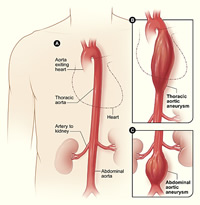Have you been diagnosed with an aortic aneurysm and been declined for life insurance or asked to pay a higher rate?

Understanding the Aorta and Aortic Aneurysms
The aorta is the largest artery in the human body and its main function is to transfer oxygen rich blood away from the heart to other arteries. The aorta arises from the left ventricle of the heart and ascends a short distance before bending over and descending through the chest and through the abdomen. It ends by dividing into two arteries that supply blood to the legs. The lower portion of the aorta is called the descending aorta which includes the thoracic aorta (descends within the chest) and the abdominal aorta (descends within the belly). Most of the body’s major arteries branch off of the aorta.
The aorta is about the same thickness as a garden hose and is much like an elastic blood vessel. Its walls have to be very flexible and pliable so that it can push the blood flow to the lower extremities as the heart contracts. Connective fibers within the aortic wall allow it to stretch as it experiences pressure, returning to its relaxed state as the force subsides. In a normal functioning aorta, these elastic fibers are present throughout and are especially dense in the wall of the upper (ascending) aorta, which experiences the greatest force with each heartbeat.
An aortic aneurysm occurs when the walls of the aorta become less flexible and begin to stretch or bulge. Usually caused by thickening of the artery called atherosclerosis, this deterioration interrupts the normal functioning of the aorta and it begins to enlarge (or become dilated) at the area of weakness. An aneurysm is present when the aorta is dilated to 4.0 cm in diameter.
Depending on the size and rate of growth, treatment for an aortic aneurysm may vary from a watch and wait scenario to emergency surgery. Once an aortic aneurysm is diagnosed, doctors will monitor it‘s size and growth so that proper treatment can be administered. As the aneurysm enlarges to 5.0 cm in diameter, there is an increased risk that it will tear (dissection) or rupture. In these cases, surgical intervention might be necessary. When the risk of aortic dissection or rupture is greater than that associated with surgery, elective surgery is offered to replace the diseased section of the aorta with a bypass graft or correct it with a stent.
Aortic Aneurysm Facts
Excessive drinking can result in significant health problems over time and is a major concern for every life insurance company. Many of the conditions below are the result of chronic alcoholism and are frequently irreversible. Some of the more serious risk factors include:
- Each year, approximately 15,000 people die of an abdominal aortic aneurysm in the United States.
- Most aneurysms are small and slow growing and rarely rupture.
- Diseases of the aorta, primarily aneurysms and dissections, are the 14th leading cause of death in the United States.
- Men develop aortic aneurysms five to 10 times more often than women do. However, women with aortic aneurysms have a risk of rupture significantly higher than do men.
- Abdominal aortic aneurysms (AAA’s) are responsible for greater than 80% of all aortic aneurysms.
- It is recommended that men ages 65 to 75 who have ever smoked should have a one-time screening for abdominal aortic aneurysms.
Risk Factors for Aortic Aneurysms
Some of the risk factors for aortic aneurysms cannot be controlled, but many of these associated factors are controllable. Life insurance companies are especially interested in these risk factors when underwriting an individual with a history of an aortic aneurysm.
- Sex. Males are much more likely to be affected than females.
- Tobacco use. Smoking significantly increases the risk of developing an aneurysm.
- Age. Aortic Aneurysms are more common in people over the age of 65.
- Lack of proper nutrition. A high fat diet is a direct cause of atherosclerosis the leading cause of aortic aneurysms.
- Lack of exercise. Exercise helps to increase good cholesterol which offsets plaque buildup and prevents hardening of the arteries.
- Build. The buildup of fat and other substances damage the lining of blood vessels.
- Family history. People with a family history are 13 to 32 percent more likely to develop an aortic aneurysms.
- High Blood Pressure. Elevated blood pressure can damage blood vessels.
How Aortic Aneurysms Affect Life Insurance Rates
Aortic aneurysms and abdominal aortic aneurysms (AAA) are serious medical conditions and therefore merit careful consideration by all life insurance companies. A diagnosis of an aneurysm does not automatically result in a decline for life insurance but a significant extra charge will likely be added. Each case will be evaluated based on the specific information contained in your medical file including physician notes and any diagnostic test results.
Of critical importance to life insurance underwriters are the size of the aneurysm, its growth rate, past and planned treatments and the presence of multiple risk factors listed above. Because the size of the aneurysm is so important, an ultrasound test or a CT scan will likely be used to get periodic measurements.
Below is a general guide to how life insurance companies will evaluate aortic aneurysms including the potential underwriting health class you can expect.
If the aneurysm has been diagnosed for more than 2 years and the condition is stable at 4.5 cm or less with no growth, a rate that is 50% to 100% higher than the standard rate is possible. There is an extreme outside chance for a better rate if there are a limited number of the risk factors listed above.
If the aneurysm is larger than 4.5 cm or it has not been stable for a period of 2 years, any life insurance application will likely be declined.
If the aneurysm has been surgically corrected and there has been a full and complete recovery with minimal risk factors above, there may be a possibility of a standard or average health rate but a rate 25% to 75% higher than the standard health rate should be anticipated.
If you have been diagnosed with an aortic aneurysm and continue to smoke or have other health concerns such as heart disease, diabetes or stroke you can expect to be declined for insurance.
How Can the Insurance Professionals at MEG Financial Help?
At MEG Financial, our experience helping others with aortic aneurysms and AAA’s find affordable life insurance is crucial to you in finding an insurance company that will treat you fairly. We represent more than 75 life insurance companies and are licensed to write life insurance in 48 states. We will “leave no stone unturned” in our efforts to help you secure the best policy!
For more specific information or to obtain a custom quote, call MEG Financial today at (877) 583-3955. You may also submit this short form and an independent insurance agent will personally contact you to go over any questions or other concerns.

 Speak with an experienced advisor!
Speak with an experienced advisor! 


